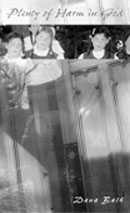
Plenty Of Harm In God
Dana Bath
DC Books
$18.95
paper
215pp
0-919688-78-0
It’s a difficult trick to pull off, especially for a first novel. (A story collection, what might have been rain, appeared in 1998.) I learned the lesson the hard way with my own first novel: to anchor down a plot like that, you need hard and fast characters. Happily, Bath’s mostly succeed.
Bath gives the six principal characters their own say in the novel, although Clare, 20 years old and pregnant, has the lion’s share. Five years earlier she came to Ireland from Newfoundland with her mother Molly; when she left Ireland she was alone, her mother dead. Now she is returning to fulfill a pact made with her cousin – and to discover if she can somehow elude her destiny.
Clare and Molly had come to stay with Molly’s sister Rosary and her Asian-Irish daughter Gillian. This is not your typical bucolic Irish family gathering: Molly regularly consults with angels, and almost immediately, the 15-year-old Clare is offered by her mother to an islander as a virgin sacrifice. Taking God and the angels’ silence as acquiescence, Molly decides it is okay for her to watch as her daughter is, essentially, raped.
“Girls, I knew,” Molly says in her first chapter introduction, “were meant for sacrifice.” That theme haunts Clare throughout the book.
Hardly any of the female characters in Bath’s twisted tour of the Aran Islands have escaped the consequences of sacrifices real or imagined. Touched by incest or rape early in their lives, their sexuality is now twisted, deformed, desperate – dysfunctional, to put it mildly. Clare flashes a boat hand on the ferry in her search for acceptance; Gillian is a Bible-reading junkie lesbian; her lover Teffia sleeps with anyone on the island, possibly including her father. The one who seems to rise above it all is Niall, the bartender: after years of literally screwing American tourists, he settles with a plain wife. The only character difficult to grasp is Teffia – the wondrous beauty of the island, always seen dancing on the sea’s edge in flowing white gowns, barefoot in the dew, a heartless pub singer who plays with hearts in the dark and stink of a bar filled with German tourists. Perhaps Bath intended her as a personification of the Irish mythology of fairies and cruel goddesses, as will-o’-the-wisp; but in a story where it’s already work to pin down reality, this reader eventually tired of Teffia, and wished that billowing dress would catch in the breeze and carry her away.
Dana Bath’s fiction escapes for the most part the self-pitying tone that we find in so many memoirs these days; there are no fingers of blame pointed, there is no psychobabble or fashionable jargon. There is pain, of course, enough pain to drive people off a cliff’s edge. But Bath’s writing is confident, plain, and breezy, with just enough forays into poetry to feel Irish. mRb






0 Comments